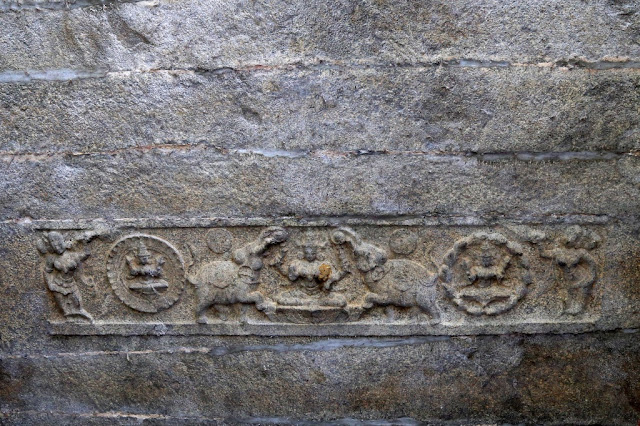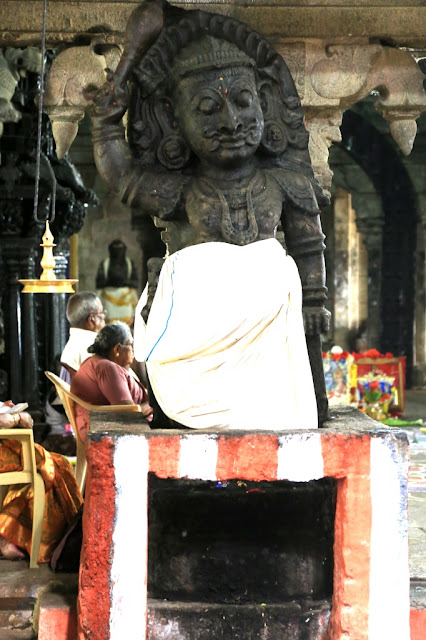Bhoothalingaswamy Temple, Boothapandi – The Temple
The
temple is said to have constructed by Pasum Pon Pandyan king somewhere between
25AD to 50AD in the name of his father. The temple is situated at the foot of
the hill known as Thadakaimalai which is considered to be the abode of Thadagai
in Ramayana. The temple faces east and there is a tank with a small Mandapa on the northern side. The presiding deity is
called Bhoothalingaswamy. The sanctorum of the temple is a crude cell excavated
on the eastern face of a huge irregular mass of rock. The Linga is also carved in the same rock. There is no vimana over this shrine.
The Ardhamandapam
and Mahamandapam were only later additions. The rock is grit round by a thick
stonewall which gives it the appearance of a minor fort. On the right side of
entrance to the sanctum is the image of Vinayak and the image of Nandi is in front of the Linga. On the right side of
Nandi facing south is Nataraja with Sivakami Ambal. Aditya, Subramanian with
valli and Deivanai, Sandikeswarar are other deities of the temple.
Outside
the prakaram(outer courtyard), anyone will be allowed pooja to the Kasi Viswanathar and Ulagayanayagi. Sthala
Vriksham is Vilwa Tree. The cave temple is excavated on the eastern slope of
the side of the hillock situated in the middle of the village. This temple
comprises of an outer prakara, inner prakara and the main cave with a frontward
pillared mandapam constituting a large complex. The rock cut cave forms nucleus
structure around which temple structures added in the subsequent period of
time. Altogether forming the large temple complex.
A large
perimeter wall in the periphery encloses the outer prakara. The temple is
accessible from four entrances. The western entrance is through three tier
gopuram or gateway. The gopuram has granite base and three-tiered brick
super-structure decorated with stucco images. The pillars, supporting base tier
of the gopuram, bear images of the donors (of the temple) appear in folded hand
gesture (mudra) On the west face of the tower there are two guards in stucco
images appear holding small and large clubs in each of their hands.
On top
of the boulder towards east of this tower, there are two stucco images: one is
a milking cow and the other one is Lord Shiva with trident. There are two
entrances on the south wall. The westward entrance arch on the south wall is
decorated with stucco image of Lord Shiva with consort Uma in Ananda-Thandava
posture. Also, there are two musicians on either side of dancing Shiva. The
eastward entrance on the south wall leads to the river Pazhayaru. The simple
entrance on the eastern wall is located before the sanctum of the prime
deity.
The
entrance on the northern wall leads to the temple tank with a mandapam in
middle. On the western side to the left of the entrance of the outer prakara
adjoining the rock slope is the shrine for Sastha. There is a Pillaiyar shrine
under the tree. The inner perimeter wall encloses the sanctums of the
prime deity, goddess Sivakami, shrines for minor deities, mandapams and inner
prakara. The parts of the inner southern and northern walls sit on the rock.
There are three entrances leading to the inner prakara: One entrance on the
southern wall, other two entrances on the eastern and northern walls.
The
eastern entrance leads to sanctum of the goddess Sivakami. Another entrance
with single tier gopuram leads to the prime sanctum. The southern entrance
leads to Pazhayaru river. This entrance is supported by adishtanam, pillars
with square, kattu, square sections, vettu-potikas and prastara components. The
ornamental arch houses the celestial wedding event: Lord Vishnu handing-over
goddess Meenakshi to Lord Sundareswarar.
The
inner prakara extends on all three sides except the rocky western side. The
inner prakara includes sanctums of god and goddess as well as shrines for minor
deities i.e., Kanni Vinayagar, Sastha and Somaskandar. Somaskanda shrine has
sanctum and mukha-mandapam and vimana with nagara Griva and shikhara. Sastha
shrine has eka-tala nagara vimana and sanctum guarded by Dwarapalakas
(boothas). Kanni Vinayagar shrine has eka-tala Vesara vimana and sanctum and
mukha-mandapam. Chandikeswara shrine and Dakshina Murti shrine are located on
the north and south side prakara of the prime deity.
There is
a shrine for Lord Muruga and his two consorts Valli and Devayani. The front of
Sivagami Ambal shrine is the best example of its sculpture. The Manmathan and Rathi are attractive to view. The chain is
made from stone. The Ramayana says Rama killed Vaali from behind. If stood in
front, Rama Vaali’s image can be seen, but if the observer is in front of
Vaali’s image, then Rama’s image cannot be seen.
A
beautiful piece of art in the temple lies in the wooden Kalyanamedai the Mandapa. It has been made so skillfully that the joints are
invisible. The Medai contains numerous multi-colored images. a Srichakkram is
engraved on the panel of pillar in the Kalyanamantapa. There is no inner prakaram for both the
shrines. On the south west corner of the common Prakaram of the shrines is Vinayaga who is locally called
“Ninaithathai Mudikkum Vinayakar”.
Mandapams:
Two
mandapams are located before the sanctums of god and goddess and they are known
as wedding mandapam and Chettiar mandapam. The wedding hall is supported by
ornate pillars with bas relief sculptures. Some are simple pillars sectioned by
square kattu and square and some other pillars are composite pillars. The cupid
or Kamadeva Manmatha and his love Rathi images appear on a pillar. The Chettiar
Hall is also supported by ornate pillars with bas relief sculptures. Some are
huge Yali pillars.
The
mukha-mandapam and large mandapams were added before the cave sanctum of the
prime deity during later age. The mukha-mandapam has supportive floor, wall
supported by square pilasters, taranga potikas and prastara components. Kapota
has ornate kudus. The large mandapam can be accessed through entrances at
east and south walls. Mandapam is supported by square kattu square kattu square
pillars with vettu potikas. The bronze idols are protected in this mandapam.
The Vinayaka idol in lalitasana posture is found in the inner mandapam.
Sivagami Amman Shrine:
The east
facing Sivagami Amman shrine has a two tier vimana, mukha-mandapam and large
mandapam. The vimana, built on a granite base with a brick superstructure, has
a kapota banda adhishtana and the vedika component is shown in between the
adhishtana and pada (wall). The octagonal (Vishnu-kanta) pilasters with nagabandha
pada support the roof. The potikas above the pillars are madalai with nanudal
tipped with sharp bud bearing the prastara components that adjoin the
roof. The three sides of the external walls are sectioned and shown as simple
koshta-panjara. The Adi-tala hara walls have been raised considerably high and
the second tala also has hara walls. The stucco images adorn in sala and griva
koshtas.
Cave Sanctum:
The Cave
sanctum is 1.71 m in the north-south direction; 1.38 m in the east-west (south
wall) direction; 1.46 m in the east-west (north wall) direction; with the
height of 1.73 m. The floor, roof and the walls of the cave sanctum are well
formed. The sanctum entrance is 0.67 cm in width and 1.60 m in height. The
sanctum houses Bhoothalingaswamy in the form of Shivalingam. Shivalingam is
sculpted out of the mother rock and the rectangular 'Avudai' measures 0.80
cm in length in the north-south; 0.75 cm in width in the east-west directions
and 0.52 cm in height.
The
external faces of Avudai is embellished with padabandha adhishtana with
components such as jagadi, vritta Kumudam, khanta flanked kampa and
pattaka mouldings. The Rudra (cylindrical) bana sits on the
square Avudai. A small pit is shown towards north to receive the anointed
water. A water chute is seen running up to the north wall of the sanctum and
continued in the east wall of the sanctum.

























